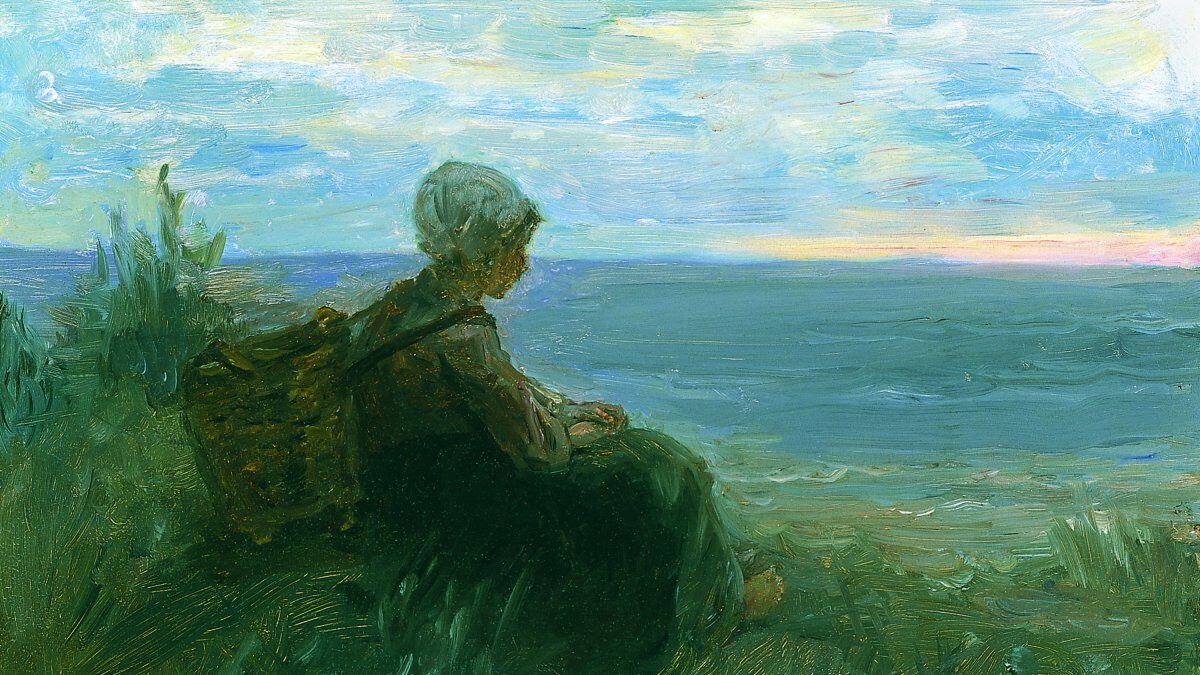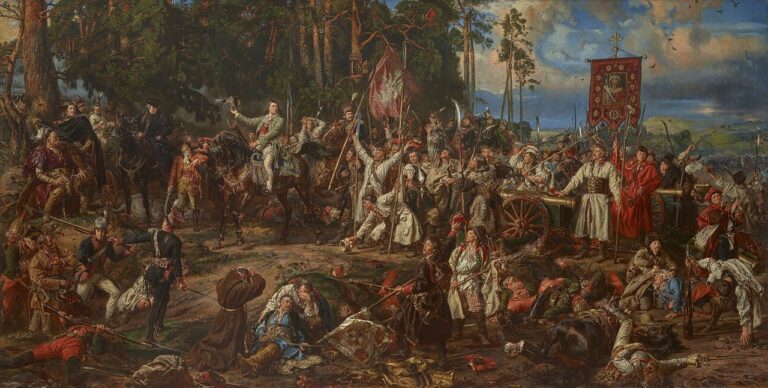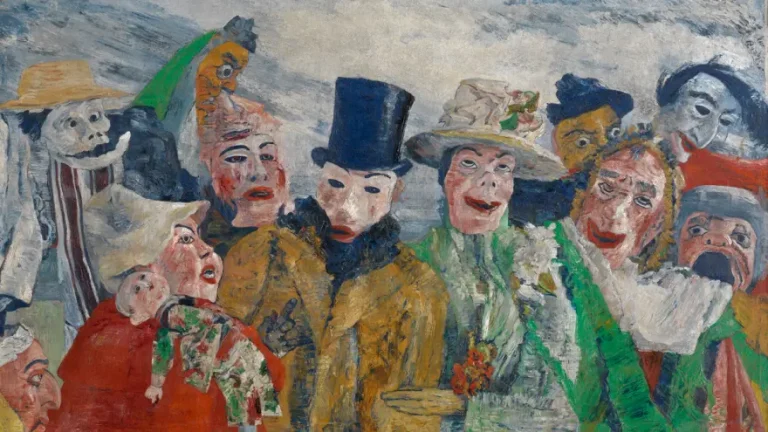Jozef Israëls Painter: Dutch Master of Realism and Compassionate Scenes
Born: 27 January 1824, Groningen, Netherlands
Death: 12 August 1911, Scheveningen, Netherlands
Art Movement: Realism
Nationality: Dutch
Teacher: Jan Kruseman, James Pradier, Horace Vernet, and Paul Delaroche
Institution: Royal Academy for Fine Arts and Ecole des Beaux-Arts
Jozef Israëls Painter: Dutch Master of Realism and Compassionate Scenes
Early Life and Education
Jozef Israëls established himself as one of the Netherlands’ most significant painters through a journey that began in his hometown of Groningen. His formative years shaped his artistic vision and technical approach before he became a leading figure in the Hague School.
Birth and Family Background
Jozef Israëls was born on January 27, 1824, in Groningen, Netherlands, to a Jewish family. His parents raised him in modest circumstances, which later influenced his empathetic portrayal of working-class subjects.
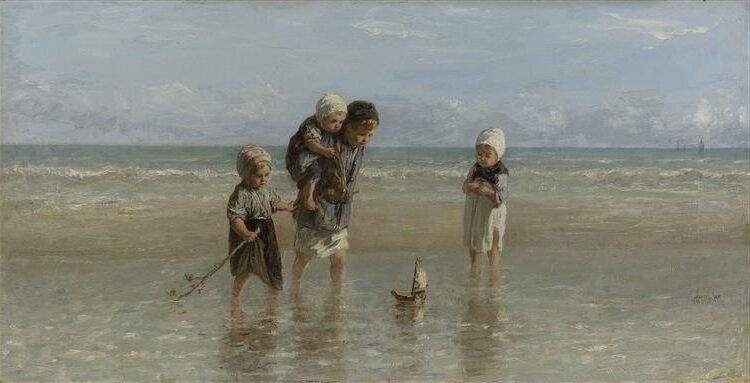
Children of the Sea (1872) by Jozef Israëls
Growing up in the northern Dutch city, young Israëls was initially expected to follow his father into business rather than pursue artistic endeavors.
The family’s Jewish heritage played an important role in shaping Israëls’ identity and would later appear as a theme in some of his works, including the notable painting “A Son of the Chosen People.”
His early exposure to the daily struggles of ordinary people in Groningen would later inform his realistic depictions of peasant life.
Artistic Training
Israëls began his formal artistic education at the Minerva Academy in his hometown of Groningen. Showing promise as a young artist, he moved to Amsterdam in the 1840s to advance his studies.
In Amsterdam, he trained at the Royal Academy for Fine Arts under the guidance of established Dutch masters.
Seeking to broaden his artistic horizons, Israëls traveled to Paris in 1845. There, he enrolled at the prestigious École des Beaux-Arts, where he was exposed to the academic traditions that dominated European art at the time.
In Paris, he studied historical painting techniques and absorbed influences from contemporary French artists. His training emphasized classical composition and historical subjects, though he would later develop his own distinctive style.
Influences and Inspirations
During his time in Paris, Israëls encountered the works of artists like Eugène Delacroix and Gustave Courbet, whose emotional intensity and realism left lasting impressions on his artistic development.
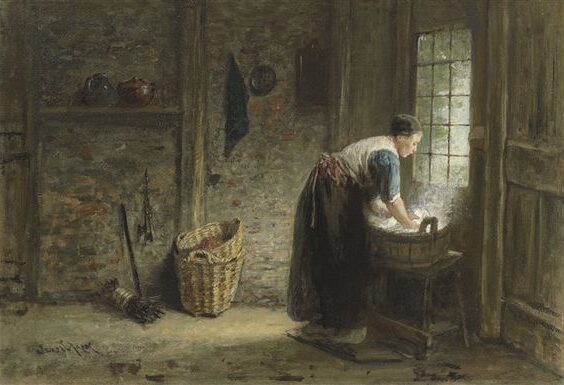
Interior Scene by Jozef Israëls
However, it was Rembrandt’s masterful use of light and shadow that most profoundly shaped Israëls’ approach to painting.
A significant turning point came when Israëls fell ill and spent time recovering in the fishing village of Zandvoort. This experience sparked his interest in the lives of fishermen and peasants along the Dutch coast.
The honest simplicity and dignity of rural working people became his primary inspiration. He developed a deep appreciation for the emotional potential of everyday scenes, moving away from the historical subjects that dominated his early training.
Artistic Style and Contributions
Jozef Israëls developed a distinctive artistic approach that merged realism with emotional depth. His work evolved from historical paintings to powerful scenes of rural and coastal life, establishing him as one of the most influential Dutch painters of the 19th century.
Development of Signature Style
Israëls began his career painting historical and biblical subjects in a Romantic style. After recovering from an illness in the fishing village of Zandvoort in 1855, his artistic direction changed dramatically. This experience sparked his interest in depicting the lives of ordinary people.
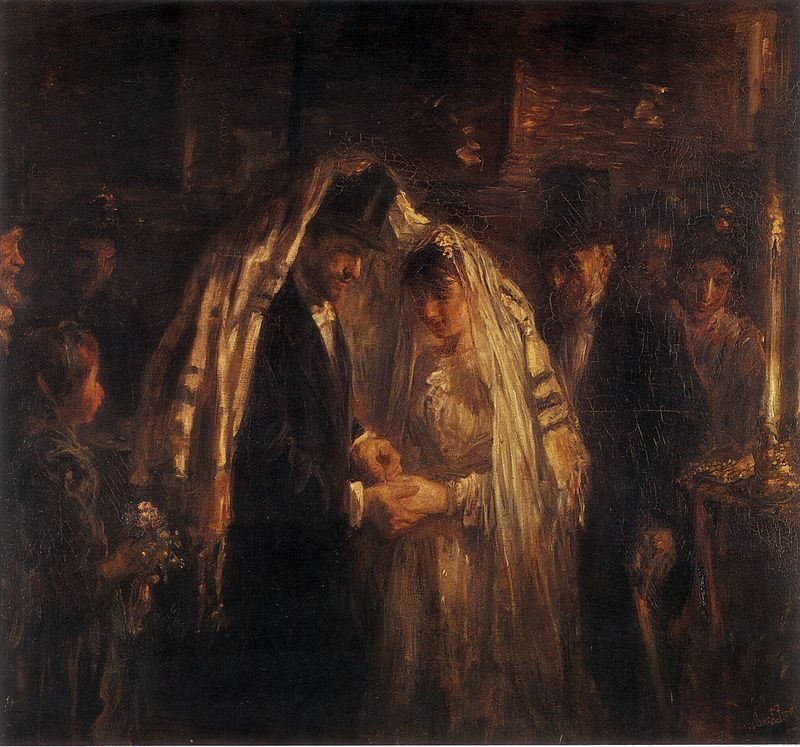
A Jewish Wedding (1903) by Jozef Israëls
His early influences included Rembrandt, whose later works inspired Israëls’ use of light and shadow. Critics often compared the two artists, a connection Israëls himself encouraged. This association helped enhance his reputation in the art world.
Over time, his style evolved from detailed precision to a looser, more atmospheric approach. His brushwork became freer, and his palette shifted to earthy tones that conveyed the somber mood of his subjects.
The Hague School and Dutch Painting
Israëls became a leading figure in the Hague School, a group of Dutch landscape painters active from around 1860 to 1890. This movement rejected academic conventions in favor of realistic depictions of everyday scenes.
The Hague School artists were sometimes called the “Gray School” for their subdued palette that captured the misty atmosphere of the Netherlands. Israëls’ influence helped shape the movement’s direction toward social realism.
His work was also compared to that of French painter Jean-François Millet, as both artists portrayed rural workers with dignity and empathy. Israëls’ contribution to the 1878 Paris Exposition firmly established his international reputation, with critics unanimously praising his paintings.
Key Themes and Subjects
Israëls focused primarily on the difficult lives of fishermen and peasants, portraying their struggles with remarkable compassion. His paintings like “Fishermen Carrying a Drowned Man” showed the harsh realities and dangers faced by coastal communities.
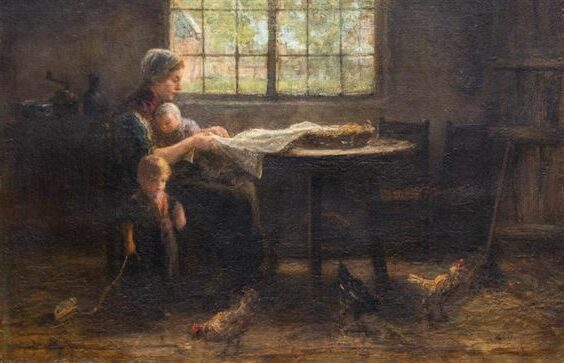
Mother and Children by Jozef Israëls
Domestic scenes formed another important subject in his work. “The Cradle” exemplifies his sensitive portrayal of family life among the working class, capturing intimate moments with emotional authenticity rather than sentimentality.
His work was characterized by psychological depth. Israëls had a unique ability to convey his subjects’ inner lives through subtle gestures and expressions. This emotional quality distinguished his paintings from more documentary approaches to similar subjects.
Israëls also painted landscapes, though usually as settings for human activity rather than as subjects themselves. His scenes typically featured muted colors and soft lighting that emphasized the mood of quiet dignity amid hardship.
Legacy and Influence
Jozef Israëls left an enduring mark on art history with his powerful depictions of peasant life and emotional scenes. His influence extended beyond his lifetime, shaping Dutch art and inspiring generations of painters who followed.
Notable Artworks and Exhibitions
Israëls’ most celebrated paintings include “Fishermen Carrying a Drowned Man” (1861), which showcases his mastery of emotional storytelling and earned him international recognition. “The Frugal Meal” (1876) exemplifies his sensitive portrayal of peasant life that earned him the nickname “Dutch Millet.”

The Frugal Meal (1876) by Jozef Israëls
His works are displayed in prestigious museums worldwide. The Rijksmuseum in Amsterdam houses a significant collection, while the National Gallery in London features several important pieces. The Art Institute of Chicago and the Museum of Fine Arts in Boston also display notable Israëls paintings.
During his lifetime, Israëls exhibited extensively across Europe. His participation in the Paris Salon and international exhibitions in Vienna, Berlin, and London helped spread his reputation beyond the Netherlands.
Recognition and Awards
Israëls received numerous honors throughout his career. He was awarded the Legion of Honor by the French government in 1867, recognizing his contributions to fine art. The Dutch government appointed him Knight in the Order of the Netherlands Lion in recognition of his artistic achievements.
Art critics of his time praised Israëls for his emotional depth and technical skill. He was compared favorably to Rembrandt for his masterful use of light and shadow to convey feeling.
His paintings commanded increasingly high prices during his lifetime, a trend that has continued in modern art markets. Several of his works have achieved record prices at auctions in recent decades.
Impact on Future Generations
Israëls founded the Hague School, a movement that profoundly influenced Dutch art in the late 19th century. His emphasis on depicting the struggles and dignity of ordinary people inspired many artists to focus on similar themes.

Alone in the World (1881) by Jozef Israëls
Vincent van Gogh expressed deep admiration for Israëls’ work. In letters to his brother Theo, van Gogh specifically mentioned being moved by Israëls’ compassionate portrayal of peasant life.
Modern art historians consider Israëls a crucial bridge between Romanticism and Realism in Dutch painting. His technique of using somber colors and dramatic lighting continues to influence contemporary artists who explore similar themes.
Art students today still study his methods of conveying emotion through subtle gestures and expressions. His ability to elicit empathy through art remains a valuable lesson for aspiring painters.
Frequently Asked Questions
Jozef Israëls left a lasting legacy in Dutch art through his emotional depictions of peasant life and mastery of light and shadow. His work bridged romanticism and realism while influencing generations of artists.
What are the key characteristics of Jozef Israëls’s painting style?
Israëls developed a distinctive style characterized by somber color palettes and emotional depth. He masterfully used light and shadow to create atmospheric scenes that evoked strong feelings.
His brushwork evolved throughout his career, beginning with more precise strokes in his early work and developing into looser, more expressive techniques later on.
Israëls focused on authentic portrayals of ordinary people, particularly fishing families and peasants. He painted their daily struggles with dignity and compassion rather than sentimentalizing their poverty.
Which artworks are considered Jozef Israëls’s most influential pieces?
“The Drowning Fisherman” (1861) established Israëls as a major artist and demonstrated his ability to capture profound human emotion during tragedy.
“Children of the Sea” (1872) exemplifies his sensitive portrayal of fishing communities and showcases his skill with depicting both interior light and human relationships.
“Son of the Old People” (1883) reveals Israëls’s talent for intimate family scenes that communicate universal themes of aging and familial bonds.
“Alone in the World” (1878) remains one of his most emotionally powerful works, depicting a widow sitting beside her deceased husband.
How did Jozef Israëls contribute to the Hague School of art?
Israëls became a central figure and spiritual leader of the Hague School, helping establish its focus on realistic scenes of rural Dutch life.
He influenced fellow Hague School artists through his emphasis on emotional content rather than merely technical skill or picturesque scenery.
Israëls helped shift Dutch painting away from academic traditions toward more personal expressions of everyday life. His work connected the group to broader European realist movements.
Can you highlight the main themes Jozef Israëls explored in his art?
Human dignity amid hardship remained a constant theme in Israëls’s work. He portrayed peasants and fishing families with respect rather than as picturesque curiosities.
The cycle of life—birth, aging, death, and grief—appears repeatedly in his paintings, often through intimate family scenes in humble settings.
Labor and toil feature prominently, showing fishermen, peasants, and their families engaged in daily work. He elevated these subjects by treating them with the seriousness previously reserved for historical or religious themes.
In what ways did Jozef Israëls’s work impact Dutch painting in the 19th century?
Israëls helped redirect Dutch art from historical and biblical scenes toward contemporary social realism. This shift influenced generations of Dutch painters.
His success internationally brought attention to Dutch art during a period of renewed national artistic identity.
Israëls bridged romanticism and realism, combining emotional depth with truthful observation. This approach created a distinctly Dutch variation of realism that differed from French models.
What are some notable exhibitions or museums where Jozef Israëls’s work has been featured?
The Rijksmuseum in Amsterdam houses a significant collection of Israëls’s paintings. Some of his most celebrated works are on display there.
The Mesdag Collection in The Hague displays important pieces by Israëls alongside other Hague School artists.
The Jewish Historical Museum in Amsterdam has featured special exhibitions on Israëls. These exhibitions highlight his cultural background and its influence on his art.
International exhibitions at the Metropolitan Museum of Art in New York and the National Gallery in London have included his work. These shows focus on 19th-century European painting.

